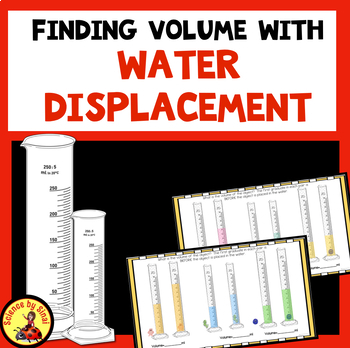Finding VOLUME with Water Displacement-BACK TO SCHOOL Activity Review Worksheet
- PPTX
Also included in
- Here are six back to school measurement review activities covering mass, liquid mass estimating, conversions, water displacement, volume of regular objects, reading a ruler and reading an analog clock. Great for unit introduction, distance learning review or assessment for math or science teachers.Price $9.60Original Price $12.00Save $2.40
- Three sets of back to school digital or printable, measurement review activity using graduate cylinders to measure volume with water displacement. Students are shown the graduate cylinders before an object is added and then after and they calculate the difference in the level of the water to find tPrice $6.80Original Price $8.50Save $1.70
- One activity covers the length x width x height of regular objects to find volume. Three products review water displacement to find the volume of irregular objects. The last one covers both as a review or assessment. Please see my blog showing how I use these activities.10 Measurement activities ThePrice $10.55Original Price $12.50Save $1.95
- Here is an 18 resource, middle school measurement unit with review, practice or assessment activities. It covers finding mass, liquid mass, ruler reading, finding the volume of regular objects, finding the volume volume using water displacement, density, elapsed time and analog clocks. There are fPrice $43.40Original Price $54.25Save $10.85
Description
Back to school measurement review activity using graduate cylinders to measure volume with water displacement. Students are shown the graduate cylinders before an object is added and then after and they calculate the difference in the level of the water to find the volume in milliliters. Digital or printable excellent supplement to working with graduate cylinders and learning how to use the meniscus as part of a unit on liquid volume. This can be used in the classroom as an introduction, for distance learning review or an assessment.
Included in this Resource:
- Teacher Notes
- Student Directions
- 2 Pages with Water Displacement Calculations
- Answers
Please see my blog showing how I use these activities.10 Measurement activities
If you have any questions at all, as to how to use these, please contact me at Karensinai2@gmail.com and I am more than happy to help you!
Are you looking for other science resources? NGSS aligned activities? Science classroom decor or clip art? Please check out the rest of my store at SCIENCE BY SINAI.
https://www.teacherspayteachers.com/Store/Science-By-Sinai
Follow Me
Do you want to be the first to find out when I post a new resource? Please click on the green star next to my name to FOLLOW MY STORE, SCIENCE BY SINAI, and to get an email each time I post a new product. As a follower you will also get notifications of freebies and sales!
Check me out on social media.
https://www.pinterest.com/karensinai2/
https://www.instagram.com/sciencebysinai/
https://www.facebook.com/Science-by-Sinai
***CHECK OUT MY BLOG FOR EXCLUSIVE FREEBIES! https://sciencebysinai.com
Feedback
**Did you know that you can save money on TpT resources by leaving feedback? Go to your “My Purchases“ page and leave feedback on the resources you’ve purchased to earn TpT credits!
Copyright.
Each purchase is a license for ONE person to use in a classroom setting. It is a violation for individuals, schools and districts to redistribute, edit, sell, or post this item on the Internet or to other individuals. Disregarding the copyright is a violation of the Digital Millennium Copyright Act and subject to legal action. By purchasing this product you acknowledge that you have read and understood these terms of use.









